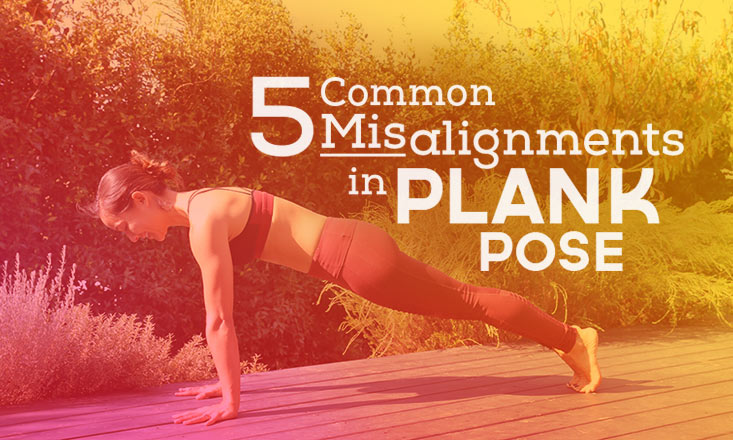The first step to deepening your yoga practice is to build a stronger understanding of foundational asanas. Plank is a tough pose that requires full body engagement, but it can also teach you so much about your habitual posture, as many of your misalignments stem from that.
All you have to do is observe your body and start to identify what your misalignments are (if any), and start to apply a couple of tools to your practice.
Yoga is a solo practice, so it can be a challenge to figure out what you’re doing in a pose, which is why I love partner work. But if that just isn’t possible, feel free to film yourself. Not to nit pick or judge your ability, just to build a deeper mind body connection.
We are such visual people that once we get a visual snapshot of what we look like, it can be easier to begin to shift and change.
In the meantime, however, here are 5 common misalignments in Plank Pose, as well as how to fix them! Your Plank will be stronger in no time.
1. Lazy Hands
 MISALIGNED
MISALIGNEDI like to start with the foundation. Misaligned or lazy hands usually cause a painful chain reaction up the arms to the shoulders, and many shoulder injuries in yoga are a result of this.
Start by realigning in Table Top. Make sure the hands are shoulder-distance apart, with the middle fingers facing forward. If you have tight or injured shoulders or wrists, turn the index fingers forward, which will help protect these parts of your body.
 ALIGNED
ALIGNEDSpread the fingers wide, and root firmly through the metacarpals (the bony knuckles at the base of each finger). Keep special attention focused on the index finger knuckle. Press this one especially firmly into the mat. When you feel strong and stable, press the toes into the ground and lift up into Plank Pose.
Keeping your hands grounded strongly into the mat provides a solid base for your Plank Pose. A strong foundation means a strong asana!
2. Scrunched-Up Neck
 MISALIGNED
MISALIGNEDIf you feel like you need a neck massage after a yoga practice, it is probably because you are over-using your pectorals and trapezius muscles while bearing weight on your arms. This is a result of "internal rotation" of your arms, and can cause your neck to scrunch up.
To protect your neck and allow it to lengthen through your Plank Pose, start to realign in Table Top. From this position, bring your shoulders directly over the wrists. Hug your hands and forearms in towards the midline of the body. Imagine you're hugging a block between your forearms, which should create the activation you want.
 ALIGNED
ALIGNEDSpread the shoulder blades wide across the back, and simultaneously hug the biceps in. Again, once you feel solid and strong, lift up into Plank Pose and feel the difference!
Make sure to practice these cues with equal energy, as they are all considered "counter actions." This means that if one is practiced too far, it could throw you off balance.
Practice with equal energy through the arms, press strongly through the knuckles of the fingers, and you'll be good to go!
3. Jelly Belly
 MISALIGNED
MISALIGNEDA lack of core engagement results in either saggy or piked hips, and can cause fatigue and sometimes even injury in your low back. I like to call this "jelly belly," and it's a very powerful fix for your Plank Pose.
Start in Table Top. On an inhale, expand the ribs, and keep them expanded as you exhale by drawing the ribs and navel in. Feel the engagement in the core which will help keep you supported in Plank.
 ALIGNED
ALIGNEDMove into Plank Pose, try the movement again, and feel the difference it makes. However, this is only half way towards a strong core…
4. Leg Power
 MISALIGNED
MISALIGNEDThis is the second half of engaging your core. Your legs are a key component to a strong Plank, and are also a support for your core.
 ALIGNED
ALIGNEDIn Plank Pose, draw the navel in towards the spine, and simultaneously lift the inner thighs up. Next, imagine that you can pull the hands to the feet and the feet to the hands. This is tough, but extremely effective! Feeling as though you could pull your hands to your feet gives you the sense of engagement in the core and the legs that you need for a solid and strong Plank.
5. Short Plank
 MISALIGNED
MISALIGNEDThis last misalignment can cause a major domino effect. If your hands and feet are too close to one another, you may have your shoulders past your wrists, and it can be almost impossible to effectively engage your legs.
 ALIGNED
ALIGNEDBegin in Plank Pose. With your shoulders directly over your wrists, step the feet back until the heels line up over the balls of the feet. Feel as if you have one long, powerful line of energy reaching from the crown of the head all the way down to the heels.
This allows you to bring all the corrections into practice, and if Plank is harder than ever now, good! That means you're doing it right.
Do you feel stronger in your Plank Pose? Let us know in the comments below!


